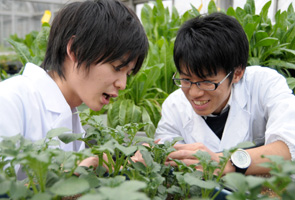Department of Agrobiology and Bioresources
Understanding of resources which grow and proliferate as well as smart use of them
 The ideal of the department is that “all living things are precious resources for us human to coexist and utilize for long periods.” To make use of these resources without disturbing environment, you have to understand their characteristics from a broad point of view of molecules, cells, physiological individuals or groups and ecosystems.
The ideal of the department is that “all living things are precious resources for us human to coexist and utilize for long periods.” To make use of these resources without disturbing environment, you have to understand their characteristics from a broad point of view of molecules, cells, physiological individuals or groups and ecosystems.
Since activities of humans are making a serious impact on natural environment right now, the department would like to educate young students who have multilevel thoughts and skills. The department is perfect for those who are wishing to study biology but cannot think of anything specific, thinking of building a bridge between basic biology and its applied science, along with those who are interested in interactions of environment and life.
Check!
- Department of Agrobiology and Bioresources is comprised of following 11 fields.
- The department is most connected with agriculture in Hokkaido, its range is extensive.
- There are many graduation researches utilizing Botanical Garden and Experiment Farm, you can undergo a wide variety of experience from field survey, crop cultivation experiment at farms, cultivation experiments and gene analyses indoors.
- We are looking for human resources who are interested in “agriculture”, “living organisms” and “nature” plus endeavor to understand scientific wisdom.
Study in Department
-
Crop Science
Current research activities: clarifying morphological and physiological characters, and genetic variability of root and shoot to make up new varieties of high tolerance for soil water and nutrients stress in field crops.
-
Crop Physiology
Current research activities: Mechanisms of tuberization, bulb formation, flower formation, bolting, dormancy of seed and tuber, apical dominance and defense response.
-
Plant Pathology
Current research activities: ecology of soilborne plant pathogens; epidemiology of soilborne diseases; biological control of soilborne diseases; population genetics of plant pathogens; classification and identification of plant pathogens.
-
Horticultural Science
Current research activities: vegetative propagation through in vitro culture; application of cell and tissue culture to breeding of the clonal crops concerned; production of transgenic plants; morphological and physiological studies on mechanisms of flowering and fruiting; freeze-preservation of useful germplasms.
-
Ornamental Plants and Landscape Architecture
Current research activities: Conservation and use of native plant species for landscape; Germination eco-physiology ;Propagation ad use of ornamental plants; Urban open space planning and landscape assessment; Recreational use and carrying capacity in natural and semi-natural areas.
-
Animal Ecology
Current research activities: Eco-evolutionary biology of wild animals; Adaptive mechanisms of living organisms to their living environments; Experimental and theoretical population genetics; Animal ecology (genetics, behavior and morphology); Rapid evolution under artificial environments; Wild animal conservation.
-
Systematic Entomology
Current research activities: taxonomic and systematic entomology; theories and methodology of taxonomy and systematics; biogeography and evolution of insects; ecology and ethology of insects; nature conservation.
-
Plant Genetics and Evolution
Current research activities: phylogeny and evolution in cultivated and wild soybeans; genetic basis of flowering and stress tolerance in soybean; Genetic modification of seed components in soybean.
-
Cell Biology and Manipulation
Current research activities: functional analysis and application of plant-related genes.
-
Pathogen-Plant Interactions
Current research activities: molecular biology of plant viruses; etiology and diagnosis of plant viral diseases.
-
Applied Plant Genomics
